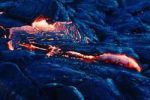Blue lava found by scientists. There is no end to the mysteries in the world. There are so many wonderful places in the world that these strange adjectives are bound to come out of the mouth when you see them visually.
When you hear about volcanoes, you usually see hot mountains laden with beautiful red lava.
But there is a place where the view of this volcano is different. Seen from a distance, the volcano looks like a stream of blue light.

The specialty of the Indonesian volcano kawah ljen is the color of the lava that comes out of this volcano is electric blue.
At night, when the lava comes out of the mouth of the volcano and descends the hill, the scene is terribly beautiful as if it is intoxicating.
This color of lava is not seen in any other volcano in the world Olivia Grunwald, a Parisian photographer, has been working on a documentary about the Cavan Yen volcano for some time.
He said the blue lava was not lava at all, but was formed when sulfuric gas came out of different parts of the volcano and came in contact with oxygen.
It then mixes with the air to form a blue fire. He said that this blue color is best seen after sunset and then this scene is unimaginable.
What is a volcano?
Volcanoes are special types of mountains through which hot and molten rocks, ashes, and gases can escape.
It is a geographical process. Hot air, water vapor, mud, molten rock, ash, gas come out with great speed through some cracks or holes.
All these emitted substances come into contact with the cool air of the earth’s surface, cool down quickly, and take on a solid shape, some of which slowly accumulate around the cracks and take on a conical shape. Then it is called “volcano”.
The release of groundwater from a volcano is called an eruption. Volcanoes are the mouths or eruptions that form outside the volcano.
About 80 volcanoes erupt each year. There are currently about half a thousand active or living volcanoes on Earth.
Read more – Google invest Rs 75,000 crore next 5 to 7 years in India
Volcanoes that have no chance of erupting are called dead or extinguished volcanoes.
Volcanic eruptions can occur if cracks appear in the crust, if there are any weak pores in the crust, or if the underground liquid rock and pressure increase.
Volcanic eruptions can cause clouds of ash and gaseous matter to form in the sky.
The liquid rock stored inside the earth is called magma, and the liquid rock that comes out of the earth’s surface is called lava.
